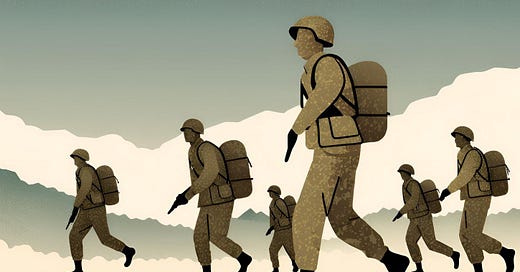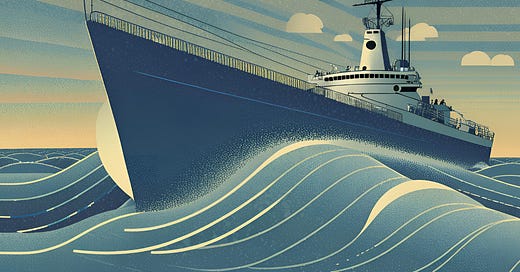
Deepening total defence: Northern Europe’s strategic advantage
The Memorandum | No. 14.2025
The Nordic countries are frontrunners in total defence, a whole-of-society approach to security. But, as Europe has to take responsibility for its own defence, the concept should be scaled up from the national to a regional level. The United Kingdom (UK), as the Nordic countries’ closest larger ally, should be integrated into the region’s total defence arrangements.
Three of the Nordic countries – Finland, Sweden and Norway – are all characterised by small populations and large territories. Finland and Norway both have populations of approximately 5.5 million, whereas Sweden is almost twice the size – around 10.5 million. These demographic and geographic conditions are relevant, as they were the main driving force behind the development of a so-called ‘total defence’ concept in the Nordic countries during the Cold War. In the Finnish and Swedish cases, the political framework of neutrality made it imperative to create a credible national ability to defend the whole country – a challenging enterprise, given a small population and a large territory. For instance, in the Finnish case, with 5.6 million people and sharing a 1,340km border with Russia, every Finn counts. Given the similar, albeit somewhat less geographically exposed, situations in the other Nordic countries, the idea that national defence is a whole-of-society effort is a regional standard.
In the current security environment – characterised by a high degree of uncertainty about the continued commitment of the United States (US) to contribute to European security – the exposed Nordic region needs to rethink its readiness arrangements.
Finland has the most developed model of total defence – called comprehensive security – which includes both whole-of-society and whole-of-government preparedness. In contrast to its Nordic neighbours, Finland maintained the system without significant decreases after the Cold War. The newest update of the Finnish ‘Security Strategy for Society’ describes comprehensive security as the foundation of resilience in Finnish society. An essential part of the Finnish comprehensive security model is the national defence courses, organised multiple times per year since 1961 by the Finnish Defence Forces, which bring together key stakeholders from society for a nearly month-long exercise, including representatives from ministries and the parliament, local administration, non-governmental organisations (NGOs), media, culture, business and critical infrastructure providers, to name but a few.
Sweden radically scaled down its preparedness post-Cold War, but has been gradually rebuilding it since Russia’s annexation of Crimea in 2014. Swedish total defence includes a significant civil defence component, with a Minister for Civil Defence in the current government and a reactivation of the Cold War era civil defence duty in 2024 for all citizens between 16 and 70 years of age. The Swedish Agency for Civil Contingencies is responsible for civil defence coordination and publishes the internationally famous brochure distributed to all citizens, giving advice in case of a crisis or war.
In Norway and Denmark, total defence has been formed with the backdrop of North Atlantic Treaty Organisation (NATO) membership since its foundation in 1949. Denmark dismantled its total defence system after the Cold War, and has not brought it back to the same extent that Sweden has, whereas Norway has continued a notion of total defence with a strong focus on civil-military cooperation as well as some whole-of-society elements. Norway recently published a new White Paper on Total Preparedness, with three main aims: preparing Norwegian society to deal with a crisis or war, to withstand hybrid attacks and to augment military efforts. Iceland, with a population of less than 400,000, cannot be considered to have a total defence system in place the same way the other Nordic countries do, as it does not have any armed forces. Instead, Iceland has a strong focus on civil preparedness.
In the current security environment – characterised by a high degree of uncertainty about the continued commitment of the United States (US) to contribute to European security – the exposed Nordic region needs to rethink its readiness arrangements. In addition to the long border between Finland and Russia, the Cap of the North region (encompassing the northernmost parts of Finland, Sweden and Norway) is in direct geographical proximity to militarily significant locations in Russia such as the Kola Peninsula, which harbours Russia’s second-strike nuclear capability.
For the Nordic countries, regional cooperation is both a reflex and a necessity. Finland and Sweden have traditionally the closest relationship, including both military and civil defence. Work is underway to widen the cooperation to include also the other Nordic countries: on the conceptual level, the Nordic Council commissioned a report on lessons from the pandemic in 2021, which it is now urging the Nordic governments to follow up on. Sweden and Iceland commissioned another report during their consecutive chairpersonships of the Nordic Council of Ministers. In the Cap of the North region, cooperation in civil preparedness is perhaps even more advanced than between the capital regions due to the nature of a sparsely populated region which requires cross-border cooperation. But, given the small size of the countries’ populations and limited military power even when combined, the region depends on larger allies’ engagement. As future US presence in Europe will likely be at least downsized, closer cooperation with larger European countries is a necessity.
As a study by the Norwegian Institute of International Affairs found in late 2021, despite Brexit, the UK has remained the most important European security partner outside the region for all four Nordic countries (not counting Iceland due to its lack of armed forces). The UK is already well integrated into the Nordic region’s military defence through NATO and the Joint Expeditionary Force (JEF), but options should be explored to also include the UK in civil contingency planning. Due to its location along the Greenland-Iceland-UK (GIUK) gap, Britain can play an important part in both military and civilian security of supply in the Nordic region – and, in a way, is also already a part of the region.
Increased domestic defence materiel production in the UK would benefit the wider Nordic region in case of a conflict and Britain could contribute to the civilian and military defence arrangements in the Danish Straits, the narrow entry point into the Baltic Sea. Finland, for example, depends on the Baltic Sea for almost 90% of its imports and exports, so securing freedom of navigation in peacetime and in conflict is essential. Given Sweden and Denmark’s somewhat limited and potentially stretched naval resources, the UK would be an important larger ally in the North Sea and Baltic Sea – not least being one of Europe’s two nuclear powers.
Apart from the military role and integration of Britain into the region already well underway, an important lesson from Ukraine’s experience is the ability to ensure that civilian life can continue even under conditions of war.
Britain could also play an important role for reinforcements and supplies through the northern land route, from Norway’s coast through the Cap of North to the presumed frontline in Finland. In this context, the UK would have an important responsibility in anti-submarine warfare, denying Russia the ability to cut off the Scandinavian peninsula from their European allies, and in keeping the North Atlantic above the GIUK gap open for reinforcements to the Nordic countries. This also touches upon the Baltic States, for whom Finland has opened up a new line of communication from the North.
Apart from the military role and integration of Britain into the region already well underway, an important lesson from Ukraine’s experience is the ability to ensure that civilian life can continue even under conditions of war. Hence, more work needs to be done to work with the UK on civil contingencies, especially the protection and resilience of energy infrastructure. If the Finnish defence course concept were scaled up to a regional level, British representatives could take part in the regional total defence exercises. As the Nordic countries and the UK are particularly exposed to the threat the Russian shadow fleet poses to undersea infrastructure, closer cooperation for better situational awareness and coordinated action is essential. Such cooperation would fit well into a regional total defence framework, as Russian hybrid warfare goes well beyond just the undersea cables and puts wider societal resilience to the test. It is a challenge which no country can deal with by itself, and which requires a much higher degree of cooperation and coordination than currently exists. The benefits and strategic advantage would be mutual, as the UK would profit from its integration into Nordic cooperation networks, gaining access to contemporary Nordic civil defence thinking to learn from for future domestic needs.
Minna Ålander is an Associate Fellow at the Chatham House Europe Programme. She is also a Non-resident Fellow at the CEPA Transatlantic Defence and Security Programme.
This article is part of the Council on Geostrategy’s Strategic Advantage Cell.
To stay up to date with Britain’s World, please subscribe or pledge your support!
What do you think about this Memorandum? Why not leave a comment below?













The strategic Midway of Europe and North America.